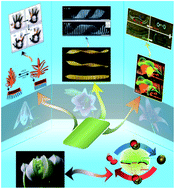From nature to synthetic systems: shape transformation in soft materials
Abstract
Nature offers a plethora of astonishing examples of shapes and functions from the aspects of both simplicity and complexity. The creation of synthetic systems that can morph in a controlled manner as seen in nature is of paramount importance in many fields of fundamental and applied sciences. The tremendous interest in self-shaping materials stems from a wide range of applications for these materials, ranging from biomedical devices to aircraft design. This review article highlights recent advances in understanding and designing thin, sheet-like soft materials that can transform into complex three-dimensional structures in a controlled manner by modulating the internal stresses. We review the general principles underlying shape transformation phenomena in natural and synthetic systems, and the significant achievements in fabricating self-shaping of soft materials via representative examples. We conclude with a discussion on the challenges facing the field, and future directions from the perspective of theoretical and experimental methodology and interdisciplinary applications.

- This article is part of the themed collection: Emerging Investigators

 Please wait while we load your content...
Please wait while we load your content...